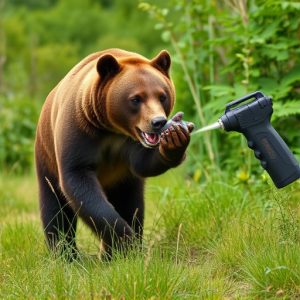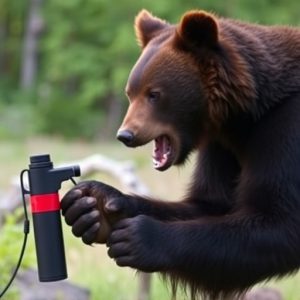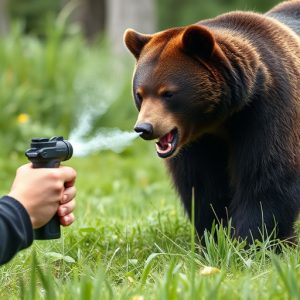Bear Spray Safety: Range, Usage, and Debunking Myths for Wilderness Travelers
Bear spray, utilizing capsaicin, is a critical tool for wilderness safety, effective within a 20-30…….
Bear spray, utilizing capsaicin, is a critical tool for wilderness safety, effective within a 20-30 foot range. This distance optimizes an invisible barrier that irritates bears' sensory areas, temporarily disorienting them. Key environmental factors like wind, terrain, and temperature impact spray effectiveness. Aiming at the bear's face ensures maximum impact, with proper usage involving aiming for eyes and nose while maintaining distance and retreating. Carrying bear spray is essential in bear-inhabited areas, understanding its limitations alongside its deterrence capabilities for effective wilderness safety.
“In the vast wilderness, encounters with bears can be a thrilling yet potentially dangerous experience. Enter bear spray—a game-changer in wilderness safety gear. This article delves into the intricacies of bear spray, offering insights on its composition, functionality, and optimal use. We explore factors influencing its range and effectiveness, providing best practices for responsible usage. Learn when and where to carry this powerful tool, and discover common myths debunked. Discover the secrets to ensuring maximum safety at the best distance for bear spray effectiveness.”
- Understanding Bear Spray: Its Composition and Functionality
- Factors Affecting Bear Spray Range and Effectiveness
- Best Practices for Using Bear Spray in the Wilderness
- When and Where to Carry Bear Spray for Maximum Safety
- Common Myths and Misconceptions About Bear Spray Efficiency
Understanding Bear Spray: Its Composition and Functionality
Bear spray is a crucial component of wilderness safety gear, designed to deter and repel bears when confronted in their natural habitat. Understanding its composition and functionality is key to ensuring its effectiveness during outdoor adventures. This specialized pepper spray contains capsaicin, the active ingredient found in chili peppers, mixed with a carrier oil and other additives to enhance its performance.
The best distance for bear spray effectiveness varies depending on factors like wind conditions and bear behavior. Typically, it’s recommended to aim for a range of 20-30 feet (6-9 meters). At this distance, the spray creates an invisible barrier of capsaicin that irritates the bear’s eyes, nose, and throat, temporarily distracting it and allowing you time to retreat or defend yourself. Remember, proper usage and awareness of the spray’s range are vital for ensuring your safety in bear country.
Factors Affecting Bear Spray Range and Effectiveness
The effectiveness of bear spray is influenced by several factors, with the best distance for optimal impact being a key consideration. Wind conditions play a significant role; spraying into an oncoming breeze can reduce the range and spread of the spray, making it less effective. Conversely, a calm day can allow the spray to linger in the air, increasing its potential reach. The angle at which the spray is directed also matters; aiming directly at the bear’s face provides the best chance of neutralizing it quickly.
The terrain and environment are equally important. Open areas with little obstructions allow for better spray distribution and visibility, while dense forests or rugged terrain can limit the spray’s reach and reduce its impact. Additionally, factors like temperature and humidity can affect the spray’s performance; colder weather may cause the spray to freeze in cold-weather scenarios, while high humidity can impact the spray’s evaporation rate.
Best Practices for Using Bear Spray in the Wilderness
When using bear spray in the wilderness, understanding the best practices is crucial for ensuring its effectiveness and safety. The optimal distance for bear spray to be successful is approximately 20-30 feet (6-9 meters). At this range, the spray can cover a wide area, creating a protective barrier around you. It’s important to remember that wind direction plays a significant role; always consider the potential path of the spray towards you or away from potential threats.
To maximize the impact, aim for the face and respiratory system of the bear. The concentration of capsaicin, the active ingredient in bear spray, is highest in these areas, temporarily disabling the bear’s sense of smell and sight, allowing you time to retreat or defend yourself. Always follow the instructions provided with your specific bear spray, as different brands may have slightly varied application techniques and safety guidelines.
When and Where to Carry Bear Spray for Maximum Safety
When and where to carry bear spray is a crucial aspect of wilderness safety. For maximum effectiveness, it’s recommended to use bear spray when you’re at a distance considered optimal for its reach—typically between 20 to 30 feet (6 to 9 meters). This range allows for the spray to cover both you and your companion(s) effectively while giving bears enough space to retreat or avoid confrontation. When navigating through dense forests, open meadows, or areas with known bear activity, carrying bear spray becomes an essential safety measure.
Bear spray should always be within easy reach, either in a belt pouch, backpack, or specialized holder designed for quick deployment. Ensure you’re familiar with the spray’s mechanism and understand how to activate it under pressure. Regularly check expiration dates on the canisters, as the effectiveness of bear spray can diminish over time. In areas known for frequent bear encounters, such as popular hiking trails, backcountry camping sites, or remote regions, having bear spray readily available can serve as a critical safety gear for both seasoned hikers and novice adventurers alike.
Common Myths and Misconceptions About Bear Spray Efficiency
Many outdoor enthusiasts carry bear spray as a crucial component of their wilderness safety kit, but there are several myths and misconceptions surrounding its effectiveness. One common misbelief is that bear spray can stop an attack instantly, ensuring immediate protection. However, it’s essential to understand that bear spray is designed to deter and temporarily incapacitate, not to kill or maim bears. The best distance for bear spray effectiveness varies based on factors like the user’s skill, wind direction, and bear behavior, but generally, it’s recommended to aim for a range of 20 to 30 feet (6 to 9 meters).
Another misconception is that spraying directly at a bear’s face guarantees success. In reality, bears have large lung capacities, allowing them to avoid inhalation. The key lies in aiming for the bear’s eyes and nose, which are more vulnerable areas. It’s crucial to remember that bear spray works best as a preventive measure; proper usage involves a quick, burst of spray while maintaining distance and retreating. Understanding these nuances can help hikers and campers make informed decisions about their safety in bear country.
Bear spray is a valuable tool for enhancing wilderness safety, but its effectiveness depends on understanding its composition, range, and best practices. Knowing the optimal distance for bear spray usage, around 20-30 feet (best distance for bear spray effectiveness), and adhering to proper application techniques can significantly reduce risks during encounters in bear country. By dispelling common myths and misconceptions, individuals can confidently navigate these wild landscapes, ensuring a safer experience for both themselves and bears.


